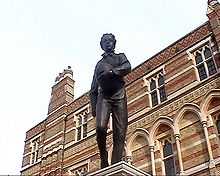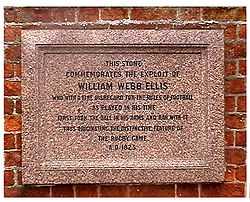William Webb Ellis
| William Webb Ellis | |
|---|---|
 | |
| Born |
24 November 1806 Salford, Greater Manchester |
| Died | 24 February 1872 (aged 65) |
| Occupation | clergyman |
Rev. William Webb Ellis (24 November 1806 – 24 February 1872) was an Anglican (English) clergyman who is famous for allegedly being the inventor of Rugby football whilst a pupil at Rugby School.
Webb Ellis's name is firmly established in rugby union folklore and the William Webb Ellis Cup is presented to the winners of the Rugby World Cup.[1][2]
Biography

Webb Ellis was born in Salford, Lancashire (some sources say he was born in Manchester as Webb Ellis himself said he was born there in the 1851 census as he later moved to the city). He was the younger of two sons of James Ellis, an officer in the Dragoon Guards, and Ann Webb, whom James married in Exeter in 1804. After his father was killed at the Battle of Albuera in 1811,[3] Mrs Ellis decided to move to Rugby, Warwickshire so that William and his older brother Thomas could receive an education at Rugby School with no cost as a local foundationer (i.e. a pupil living within a radius of 10 miles of the Rugby Clock Tower). He attended the school from 1816 to 1825 and was recorded as being a good scholar and cricketer, although it was noted that he was "rather inclined to take unfair advantage at cricket". The incident in which Webb Ellis supposedly caught the ball in his arms during a football match (which was allowed) and ran with it (which was not) is supposed to have happened in the latter half of 1823.
After leaving Rugby in 1826, he went to Brasenose College, Oxford, aged 20. He played cricket for his college, and for Oxford University against Cambridge University in a first-class match in 1827.[4] He graduated with a BA in 1829 and received his MA in 1831. He entered the Church and became chaplain of St George's Chapel, Albemarle Street, London (closed c.1909),[5] and then rector of St. Clement Danes in The Strand. He became well known as a low church evangelical clergyman. In 1855, he became rector of Magdalen Laver in Essex. A picture of him (the only known portrait) appeared in the Illustrated London News in 1854, after he gave a particularly stirring sermon on the subject of the Crimean War.
He never married and died in the south of France in 1872, leaving an estate of £9,000, mostly to various charities. His grave in "le cimetière du vieux château" at Menton in Alpes Maritimes was rediscovered by Ross McWhirter in 1958 and has since been renovated by the French Rugby Federation.
The legend
Origin of the claim
The sole source of the story of Webb Ellis picking up the ball originates with one Matthew Bloxam, a local antiquarian and former pupil of Rugby.[2] On 10 October 1876,[6] he wrote to The Meteor, the Rugby School magazine, that he had learnt from an unnamed source that the change from a kicking game to a handling game had "...originated with a town boy or foundationer of the name of Ellis, Webb Ellis".
On 22 December 1880,[6] in another letter to the Meteor, Bloxam elaborates on the story:
- "A boy of the name Ellis – William Webb Ellis – a town boy and a foundationer, ... whilst playing Bigside at football in that half-year [1823], caught the ball in his arms. This being so, according to the then rules, he ought to have retired back as far as he pleased, without parting with the ball, for the combatants on the opposite side could only advance to the spot where he had caught the ball, and were unable to rush forward till he had either punted it or had placed it for some one else to kick, for it was by means of these placed kicks that most of the goals were in those days kicked, but the moment the ball touched the ground the opposite side might rush on. Ellis, for the first time, disregarded this rule, and on catching the ball, instead of retiring backwards, rushed forwards with the ball in his hands towards the opposite goal, with what result as to the game I know not, neither do I know how this infringement of a well-known rule was followed up, or when it became, as it is now, a standing rule."
Bloxham's first account differed from his second one four years later. In his first letter, in 1876, Bloxham claimed that Webb Ellis committed the act in 1824, a time by which Webb Ellis had left Rugby.[6] In his second letter, in 1880, Bloxham put the year as 1823.[6]
1895 investigation
The claim that Webb Ellis invented the game did not surface until four years after his death and doubts have been raised about the story since 1895, when it was first investigated by the Old Rugbeian Society. The sub-committee conducting the investigation was "unable to procure any first hand evidence of the occurrence".[7]
Among those giving evidence, Thomas Harris and his brother John, who had left Rugby in 1828 and 1832 respectively (i.e. after the alleged Webb Ellis incident) recalled that handling of the ball was strictly forbidden. Harris, who requested that he "not [be] quote[d] as an authority", testified that Webb Ellis had been known as someone to take an "unfair advantage at football".[7] Harris, who would have been aged 10 years at the time of the alleged incident, did not claim to have been a witness to it, additionally, he stated that he had not heard the story of Webb Ellis' creation of the game.[7]
Thomas Hughes (author of Tom Brown's Schooldays) was asked to comment on the game as played when he attended the school (1834–1842). He is quoted as saying "In my first year, 1834, running with the ball to get a try by touching down within goal was not absolutely forbidden, but a jury of Rugby boys of that day would almost certainly have found a verdict of 'justifiable homicide' if a boy had been killed in running in."
It has been suggested by Dunning and Sheard (2005) that it was no coincidence that this investigation was conducted in 1895, at a time when divisions within the sport led to the schism; the split into the sports of league and union.[2] Dunning and Sheard suggest that the endorsement of a "reductionist" origin myth by the Rugbeians was an attempt to assert their school's position and authority over a sport that they were losing control of.[2]
The plaque
A plaque, erected in 1895, at Rugby School bears the inscription:[2]
|
THIS STONE |
 Image of the plaque at Rugby School |
Controversy
There is also much speculation as to what kind of rules were in place for football at the Rugby School. Some sources have claimed that the rules of the game being played were constantly altered. Malcolm Lee said in an interview that "...the rules were discussed almost every time the boys went out to play and that adjustments were frequently made [to the game]"[8]
Rugby Union Football was not "invented" by Rugby School but by Blackheath FC. Rugby School were figureheads and were not even members of the Union for many years. Blackheath joined the Football Association but when the members voted against hacking (shin kicking) Blackheath resigned.[9] The split in football was not about running with the ball but about hacking. The original rules of Rugby Union allowed hacking but within a year it had to be banned because there were suggestions that the game was too violent and should be suppressed.[10]
See also
- Abner Doubleday, sometimes apocryphally credited with inventing baseball
- Tom Wills, Old Rugbeian and co-inventor of Australian rules football
References
- ↑ Davies, Sean (10 August 2007). "William Webb Ellis – fact or fiction?". BBC. Retrieved 2009-10-23.
- ↑ 2.0 2.1 2.2 2.3 2.4 Eric Dunning, Kenneth Sheard (2005). "Part I: 2. Football in the early-nineteenth-century public schools". Barbarians, gentlemen and players: a sociological study of the development of rugby football (2nd ed.). Oxon: Routledge. pp. 52–53. ISBN 0-7146-5353-5. Retrieved 2009-10-24. (ISBN 9780714653532)
- ↑ According to military records, no man by the name of James Ellis (or any other Ellis) was killed or died of their wounds at the battle of Albuera in 1811. Having checked the records for all the 3rd & 4th Dragoon Guards, 13th Light Dragoons and all the infantry battalions, only the Royal Artillery records have not been checked. It appears unlikely that James Ellis was killed at Albuera.
- ↑ CricketArchive – William Webb Ellis. Retrieved 10 April 2013.
- ↑ St George’s, (1740? -1909?) was a proprietary chapel in Albemarle Street, and located opposite the Royal Institution. It was a fashionable chapel, where the Reverend W W Ellis preached sermons. The chapel backed onto St George’s hotel, which was purchased in 1889 by Brown’s hotel (founded in 1837 by James Brown, onetime valet to Lord Byron). The two hotels were incorporated into the enlarged Brown’s hotel. St. George's is remembered -becoming the name for the hotel's bar and the historic merger is recorded at the entrance to the hotel.
- ↑ 6.0 6.1 6.2 6.3 (Harvey 2005, p. 246)
- ↑ 7.0 7.1 7.2 (Harvey 2005, p. 247)
- ↑ http://www.pshortell.demon.co.uk/rugby/wwe.htm
- ↑ Official History of the Football Association 1953
- ↑ Percy Young – A History of British Football 1968
General
- Harvey, Adrian (2005). Football: the first hundred years : the untold story. Oxon: Routledge. ISBN 0-415-35019-0. Retrieved 2009-10-24. (ISBN 9780415350198)
- K. G. Sheard, "Ellis, William Webb (1806–1872)", Oxford Dictionary of National Biography, Oxford University Press, Sept 2004; online edn, Oct 2006 accessed 23 October 2007
- Rev. William Webb Ellis, Sermons: Preached in St. George's Chapel, Albemarle Street; to Which Is Added, an Essay On the Prophecies Relative to Christ, published prior to 1923
External links
- Richard Lindon inventor of the "Oval" ball, the rubber bladder and the Brass Hand pump
- Ron Schuler's Parlour Tricks: Fine Disregard of the Rules
- CricketArchive: William Ellis
|